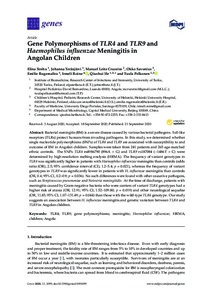Gene Polymorphisms of TLR4 and TLR9 and Haemophilus influenzae Meningitis in Angolan Children
Elina Tenhu; Johanna Teräsjärvi; Manuel Leite Cruzeiro; Okko Savonius; Emilie Rugemalira; Irmeli Roine; Qiushui He; Tuula Pelkonen
Gene Polymorphisms of TLR4 and TLR9 and Haemophilus influenzae Meningitis in Angolan Children
Elina Tenhu
Johanna Teräsjärvi
Manuel Leite Cruzeiro
Okko Savonius
Emilie Rugemalira
Irmeli Roine
Qiushui He
Tuula Pelkonen
MDPI
Julkaisun pysyvä osoite on:
https://urn.fi/URN:NBN:fi-fe2021042821308
https://urn.fi/URN:NBN:fi-fe2021042821308
Tiivistelmä
Bacterial meningitis (BM) is a severe disease caused by various
bacterial pathogens. Toll-like receptors (TLRs) protect humans from
invading pathogens. In this study, we determined whether single
nucleotide polymorphisms (SNPs) of TLR4 and TLR9
are associated with susceptibility to and outcome of BM in Angolan
children. Samples were taken from 241 patients and 265 age-matched
ethnic controls. The SNPs TLR4 rs4986790 (896A > G) and TLR9 rs187084 (−1486T > C) were determined by high-resolution melting analysis (HRMA). The frequency of variant genotypes in TLR4 was significantly higher in patients with Haemophilus influenzae meningitis than controls (odds ratio (OR), 2.5; 95% confidence interval (CI), 1.2–5.4; p = 0.021), whereas the frequency of variant genotypes in TLR9 was significantly lower in patients with H. influenzae meningitis than controls (OR, 0.4; 95% CI, 0.2–0.9; p = 0.036). No such differences were found with other causative pathogens, such as Streptococcus pneumoniae and Neisseria meningitidis. At the time of discharge, patients with meningitis caused by Gram-negative bacteria who were carriers of variant TLR4 genotypes had a higher risk of ataxia (OR, 12.91; 95% CI, 1.52–109.80; p = 0.019) and other neurological sequelae (OR, 11.85; 95% CI, 1.07–131.49; p = 0.044) than those with the wild-type TLR4 genotype. Our study suggests an association between H. influenzae meningitis and genetic variation between TLR4 and TLR9 in Angolan children.
bacterial pathogens. Toll-like receptors (TLRs) protect humans from
invading pathogens. In this study, we determined whether single
nucleotide polymorphisms (SNPs) of TLR4 and TLR9
are associated with susceptibility to and outcome of BM in Angolan
children. Samples were taken from 241 patients and 265 age-matched
ethnic controls. The SNPs TLR4 rs4986790 (896A > G) and TLR9 rs187084 (−1486T > C) were determined by high-resolution melting analysis (HRMA). The frequency of variant genotypes in TLR4 was significantly higher in patients with Haemophilus influenzae meningitis than controls (odds ratio (OR), 2.5; 95% confidence interval (CI), 1.2–5.4; p = 0.021), whereas the frequency of variant genotypes in TLR9 was significantly lower in patients with H. influenzae meningitis than controls (OR, 0.4; 95% CI, 0.2–0.9; p = 0.036). No such differences were found with other causative pathogens, such as Streptococcus pneumoniae and Neisseria meningitidis. At the time of discharge, patients with meningitis caused by Gram-negative bacteria who were carriers of variant TLR4 genotypes had a higher risk of ataxia (OR, 12.91; 95% CI, 1.52–109.80; p = 0.019) and other neurological sequelae (OR, 11.85; 95% CI, 1.07–131.49; p = 0.044) than those with the wild-type TLR4 genotype. Our study suggests an association between H. influenzae meningitis and genetic variation between TLR4 and TLR9 in Angolan children.
Kokoelmat
- Rinnakkaistallenteet [27094]
